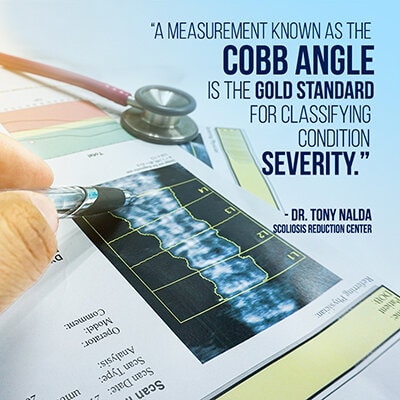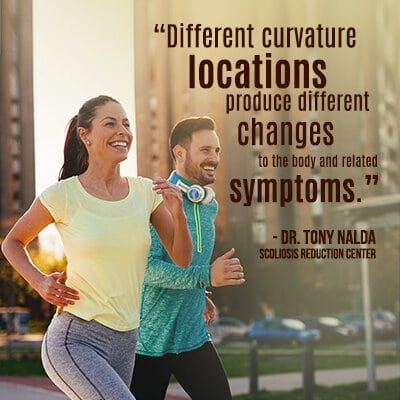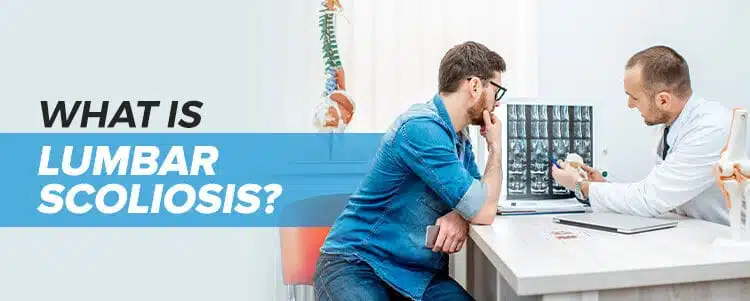Lumbar scoliosis is a classification of the condition based on where the curve is located along the spine. ‘Lumbar’ refers to the lower part of the spine. If a patient has an abnormal spinal curvature located in the lumbar region of the spine, it’s classified as ‘lumbar scoliosis’.
How Scoliosis is Classified
Scoliosis is a condition that varies greatly from patient to patient and can take many forms; that’s why it’s so important for the condition to be classified accurately. This is not just for the benefit of having consistent documentation of a patient’s condition for medical professionals; it’s also to ensure the patient gets the best possible course of treatment.
Classifying a patient’s scoliosis is done by age, size of the curve, location of the curve, and the cause of the condition. These are the most important aspects of the condition that help determine a patient’s best course of treatment.
Age of Patient
Scoliosis can affect infants, juveniles, adolescents, and adults. The first stage of classifying a patient’s condition starts with age.
As scoliosis is progressive, age determines a lot about a patient’s condition and the rate of its progression. While every case is different and there is no reliable formula for calculating progression rates, age can tell us how a condition is ‘most likely’ to progress, and this information helps us determine how to approach treatment.
- Infantile scoliosis – scoliosis that affects babies from birth to the age of 3
- Juvenile scoliosis – scoliosis that affects children from the ages of 4 to 10
- Adolescent scoliosis – scoliosis that affects people from the ages of 10 to 18
- Adult de novo scoliosis – scoliosis that affects adults 18 and over
Infants born with the condition or who develop it before the age of 3 are growing steadily, meaning that progression will likely be slow.
As juveniles have not yet had the big growth spurts associated with puberty, the treatment goal is to achieve a curvature reduction and hold it so the rapid growth spurts that characterize puberty won’t cause rapid progression.
When it comes to adolescents, this is the age group most commonly affected by scoliosis, and progression is the main concern as we know rapid growth will occur during this stage.

With adults, we know that rapid growth is not going to be such an issue, but pain management will be as the curvature causes compression of the spine and its surrounding nerves and tissues.
Curve Size to Determine Condition Severity
The next stage of classifying a patient’s scoliosis is by the size of the curve. Knowing a patient’s size of curve means knowing if the condition is mild, moderate, or severe. The size of a patient’s curvature is measured via X-ray.
A measurement known as the Cobb angle is the gold standard for classifying condition severity. The Cobb angle measurement will tell us just how far a patient’s curvature deviates from a straight alignment. The apex of the curve helps determine the Cobb angle and refers to the vertebra or disk with the largest rotation or farthest deviation from the vertebral column’s center. As the end vertebrae have the largest tilt towards the curve’s apex, these are used to measure the Cobb angle.
- Mild scoliosis: cases where the Cobb angle measures at 25 degrees or less
- Moderate scoliosis: cases where the Cobb angle measures between 25 and 40 degrees
- Severe scoliosis: cases where the Cobb angle measure 40+ for adolescents and 50+ for adults
Knowing the size of a patient’s curvature tells us how much work we have to do to achieve a reduction. It also tells us what, if any, symptoms our patients are likely to experience, and this information helps us design a treatment plan that responds to our patient’s symptoms and helps them live their best lives.
Location of the Curve

In addition to the size of the curve, where the curve is located along the spine is also important. Different curvature locations produce different changes to the body and related symptoms. This is where the ‘lumbar’ designation comes into play.
If a patient’s curvature is on the spine’s middle portion, it’s classified as ‘thoracic scoliosis’. If a curvature is located on the lower portion of the spine, this is classified as ‘lumbar scoliosis’. A patient whose curvature includes the lower-thoracic and upper-lumbar portions is considered a combined scoliosis and is classed as ‘thoracolumbar’.
Knowing the location of a patient’s curvature is crucial information when it comes to adjustments and scoliosis-specific chiropractic care, as well as anticipating how it will affect the body and the types of symptoms the patient will be living with.
Cause of the Condition
A condition’s cause can help determine the best course of treatment. When it comes to scoliosis, we know that 80 percent of cases are idiopathic, meaning they have no known single cause. Adolescent idiopathic scoliosis is by far the most common form of the condition. For the bulk of scoliosis cases, the cause is unknown. While it would be beneficial to know the cause for every form of scoliosis, effective treatment is not dependent upon it.
There is, however, the remaining 20 percent of cases that experts have been able to assign causes to. Following is a list of condition types with known causes.
- Neuromuscular: neuromuscular scoliosis develops as a secondary complication of a medical condition where the body’s ability to control the muscles that support the spine is impaired. Most commonly associated with children diagnosed with cerebral palsy, spina bifida, and muscular dystrophy.
- Congenital: congenital scoliosis develops from a bone malformation that occured during gestation. Also associated with children, the inability of the vertebrae to form properly can cause a spinal curvature to develop.
- Traumatic: traumatic scoliosis develops due to a trauma that has been suffered by the spine.
- Degenerative: degenerative scoliosis develops in older people as the natural effects of aging causes spinal degeneration to occur. When vertebrae or discs start to move because of degeneration, a spinal curvature can develop.
Specifics of Lumbar Scoliosis
Lumbar scoliosis is the designation given to a patient with an abnormal spinal curvature that is located along the spine’s lower portion: lumbar. Most cases of degenerative scoliosis occur in the lumbar region and are most common in adults over 50.
Pain levels associated with lumbar scoliosis can be more extreme than other forms of the condition because it is associated mainly with adults. Scoliosis in younger people is often a painless condition; this is because during growth, the spine is lengthening. Once growth has stopped, such as in adulthood, the curvature can cause compression of the spine and surrounding nerves, causing pain and discomfort.
Symptoms associated with lumbar scoliosis include the appearance of one hip sitting higher than the other and legs that appear to be different lengths. A curvature in the spine’s lower portion can also put extra strain on joints, causing inflammation and pain.
Conclusion
Once all pathology has been ruled out and a patient’s curvature has been located along the lower portion of the spine, a classification of ‘lumbar scoliosis’ can be given. Following along the path of the classification system and the touch-points mentioned, the patient’s age, condition severity based on curve size, curve location, and cause will be combined for a full classification such as ‘adolescent idiopathic moderate lumbar scoliosis’.
When a medical professional reads that classification, they know the most important aspects of the patient’s scoliosis and, from there, can start designing and implementing an effective treatment plan.
Knowing the location of the curvature along the spine is important information in terms of treatment and preparing the patient for what bodily changes and symptoms they are likely to experience. With a curvature located along the spine’s lower region, common changes and symptoms include asymmetrical hips and legs and related pain due to compression of the spine and surrounding nerves. It can also cause more wear and tear on the joints and inflammation, also known to cause pain and discomfort.
If you or a loved one has recently been diagnosed with lumbar scoliosis, the Scoliosis Reduction Center® can help. We offer a patient-centered and functional chiropractic approach to treatment that combines multiple approaches to produce the best results.
My team is made up of experts from multiple disciplines so our patients can benefit from the very best of what a variety of treatment options have to offer.





